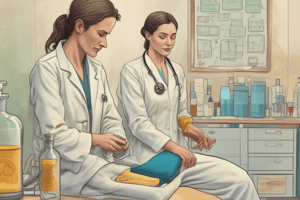Podcast
Questions and Answers
Where should a doctor stand when examining a patient?
Where should a doctor stand when examining a patient?
- On the left side of the patient
- Behind the patient
- On the right side of the patient (correct)
- At the foot of the bed
What is the term for the bluish discoloration of skin and mucous membranes?
What is the term for the bluish discoloration of skin and mucous membranes?
- Cyanosis (correct)
- Oedema
- Jaundice
- Pallor
What is the BMI range for overweight?
What is the BMI range for overweight?
- 25-30 (correct)
- 35-40
- 30-35
- 18.5-25
What is the term for the proliferation of soft tissues at nail beds and terminal phalanges?
What is the term for the proliferation of soft tissues at nail beds and terminal phalanges?
What is the term for the abnormal accumulation of fluid in the interstitial tissue?
What is the term for the abnormal accumulation of fluid in the interstitial tissue?
Why is the patient's name important in history taking?
Why is the patient's name important in history taking?
What is the term for the distance from the occiput to the heel in an upright position?
What is the term for the distance from the occiput to the heel in an upright position?
What is the level of bilirubin above which jaundice appears?
What is the level of bilirubin above which jaundice appears?
What is the term for the measurement of how many times the heart beats in one minute?
What is the term for the measurement of how many times the heart beats in one minute?
If a patient's pulse is 25 beats in 15 seconds, what is their heart rate?
If a patient's pulse is 25 beats in 15 seconds, what is their heart rate?
What is the normal pulse rate in beats per minute?
What is the normal pulse rate in beats per minute?
Where is the radial pulse typically assessed?
Where is the radial pulse typically assessed?
What is the term for a resting pulse rate above 100 beats per minute in an adult?
What is the term for a resting pulse rate above 100 beats per minute in an adult?
What is the site at which the pulse is most commonly taken?
What is the site at which the pulse is most commonly taken?
What does the pulse indicate about the cardiovascular system?
What does the pulse indicate about the cardiovascular system?
Where is the apical pulse typically measured?
Where is the apical pulse typically measured?
Flashcards are hidden until you start studying
Study Notes
Physical Examination
- Doctor should stand on the right side of the patient during examination.
- Yellow discoloration of skin and mucous membranes indicates Jaundice.
- Bluish discoloration of skin and mucous membranes indicates Cyanosis.
- Sites of examination for pallor: inner aspect of lips, skin of the face, nails, and palm creases.
- Peripheral cyanosis is not detected on the tongue.
Anthropometry
- Height is defined as the distance from occiput to heel in an upright position.
- Span is defined as the distance between the tips of the middle finger with outstretched hands.
- Underweight is diagnosed when BMI is below 18.5.
- Overweight is diagnosed when BMI is 25-30.
- Obesity is diagnosed when BMI is over 30.
Clinical Signs
- Jaundice appears when bilirubin level is above 2.5 mg/dl.
- Cyanosis appears when reduced Hb level is above 5 gm/dl.
- Clubbing means proliferation of soft tissues at nail beds and terminal phalanges.
- Grades of clubbing:
- Grade I: Obliteration of the angle between nail and nail bed.
- Grade II: Increase convexity of nails in its longitudinal curve (parrot beak).
- Grade III: Hypertrophy of terminal phalanx (drum stick).
- Grade IV: Hypertrophy of distal ends of long bones at wrist and ankle (hypertrophic osteoarthropathy).
History Taking
- Name of the patient is important in history taking as it improves patient-doctor relationship.
- Congenital disease is common in young age.
- Malignancy is common in age more than 60 years.
- Bilharziasis is commonly present in farmers.
- Hepatitis C viral infection is endemic in Egypt.
- Covid-19 is not categorized as a blood-borne infection.
- History of previous diseases and operations are components of past history.
- Patient's smoking index is calculated by multiplying the number of cigarettes per day by the number of years.
- Toxic dose of alcohol is 60-80 gm per day.
Pulse and Heart Rate
- Pulse is the throbbing of arteries as blood moves through them.
- Pulse can be measured by using the fingers to feel an artery near the skin.
- Heart rate is the number of times the heart beats in one minute.
- Normal pulse rate is between 60 and 100 beats per minute.
- Pulse rate above 100 beats per minute indicates Tachycardia.
- Pulse rate below 60 beats per minute indicates Bradycardia.
- Palpation sites: radial, carotid, brachial.
- Apical pulse is measured over the heart.
- Factors that determine blood pressure: pumping action of the heart, peripheral resistance, and blood viscosity.
Studying That Suits You
Use AI to generate personalized quizzes and flashcards to suit your learning preferences.




